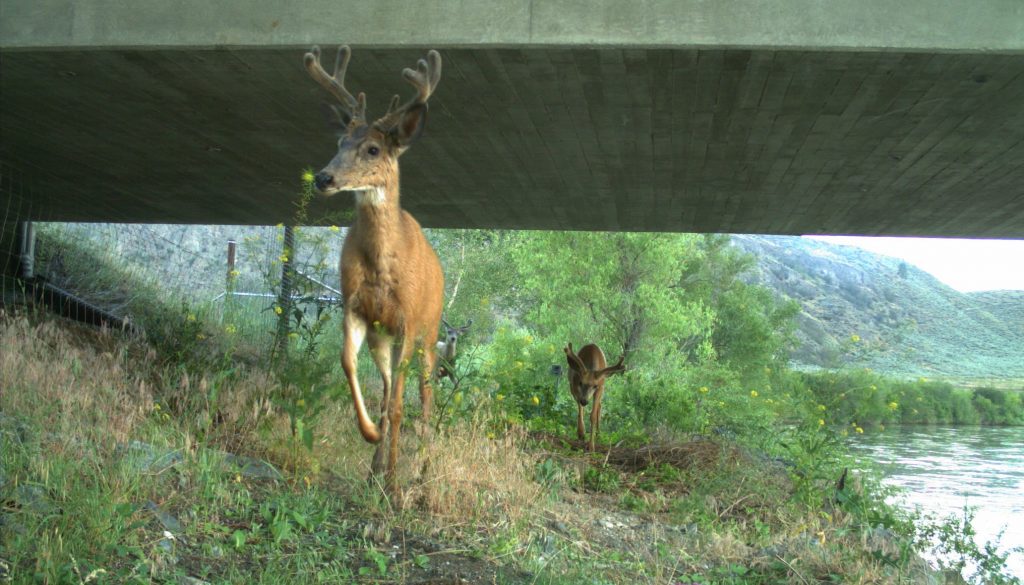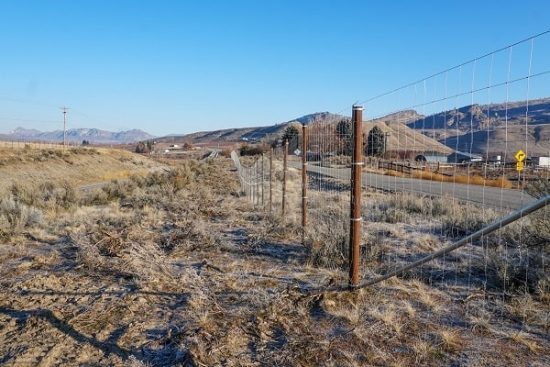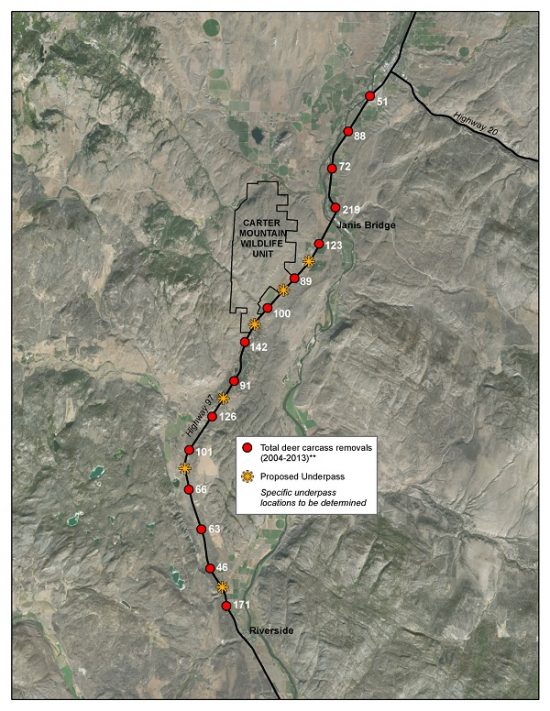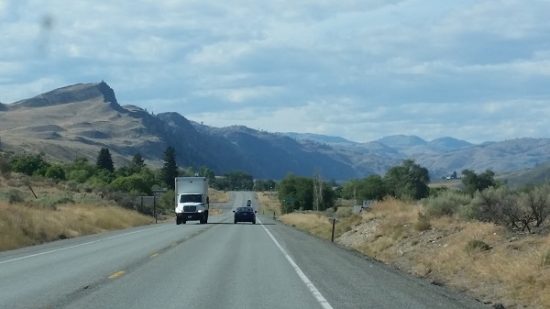
Private Donations Help Wrap Up Phase 1 Of Okanogan Wildlife/Driver Safety Project; Lawmakers Asked To Publicly Fund More Work
(Editor’s note: See my previous coverage here.
THE FOLLOWING IS A PRESS RELEASE FROM CONSERVATION NORTHWEST
Conservation Northwest is proud to announce the completion of the first phase of the Safe Passage 97 project, with work concluding this month on the renovation of Janis Bridge to serve as a wildlife undercrossing, deer fencing completed on either side of Highway 97 for one mile south of the bridge, and required gates and cattle-guards installed at access roads within the project area.

“Deer-vehicle collisions have been a major problem in this stretch of Highway 97 in the Okanogan Valley, and everyone in my community has a story of hitting or almost hitting a deer in this area,” said project manager Jay Kehne, Conservation Northwest’s Sagelands Program Lead based in Omak.

“The work completed in this phase of the Safe Passage 97 project is expected to prevent more than 100 animal collisions per year, making drivers safer and helping reconnect a critical mule deer migration route,” said Kehne.
“After years of advocating for this project locally and in Olympia, we’re proud to have been able to complete this first phase with private funding, and are so grateful to everyone who pitched in to make it possible. Thank you!” noted Kehne.
“Now it’s up to state lawmakers in Olympia to provide public funding for WSDOT to complete the remaining phases of this critical driver and wildlife safety effort under the 2021 Transportation Budget.”
This first phase of the Safe Passage 97 project was made possible by more than $180,000 in private funds raised by over 570 individual Conservation Northwest donors, as well as additional funds from the Okanogan Trails Chapter of the Mule Deer Foundation and Mule Deer Foundation chapters around Washington state, as well as other organizations and private foundations, including:
· Mule Deer Foundation
· National Wildlife Federation
· Backcountry Hunters & Anglers Washington Chapter
· Audubon Washington
· Community Foundation of North Central Washington
· Moccasin Lake Foundation
· James M. Lea Foundation
· The Volgenau Foundation
· Bass Pro Shops and Cabela’s Outdoor Fund
“We’re lucky to have such dedicated supporters invested in projects like this that are a win-win for the people and wildlife of Washington,” said Matthew Brouwer, Conservation Northwest Development Director. “When Olympia failed to act, our donors, foundations and partners stepped up in a big way to get the Safe Passage 97 project started, and lives will be saved because of their support,” said Brouwer.


Project leaders are also grateful to the Washington State Department of Transportation (WSDOT), Washington Department of Fish and Wildlife (WDFW), the Colville Confederated Tribes and Okanogan County Public Works for their support, guidance and coordination on behalf of the Safe Passage 97 project. Numerous local and regional contractors and companies also assisted with the project.

This first, private phase of the Safe Passage 97 project includes renovation of the Janis Bridge Wildlife Undercrossing and deer fencing for one mile south nearly to the Carter Mountain Wildlife Area in north-central Washington’s Okanogan Valley (https://goo.gl/maps/ZtqWjmncx18H6TA26).
The Safe Passage 97 project was conceived in 2013 by the Okanogan Trails Chapter of the Mule Deer Foundation, Conservation Northwest and other partners involved in the Working for Wildlife Initiative, a collaborative effort funded by the National Fish and Wildlife Foundation (NFWF) and coordinated by Conservation Northwest to protect wildlife habitat, working lands and natural heritage in the diverse landscape of the Okanogan Valley and Kettle River Mountain Range.
Project partners initially focused on advocating for state funding for a transportation and wildlife safety project in the 13-mile stretch of Highway 97 between Riverside and Tonasket in Okanogan County notorious for more than 350 deer-vehicle collisions each year, and identified by biologists as critical for wildlife connectivity between the North Cascades to the west and the Okanogan Highlands and Kettle Range to the east. Mule deer in particular move through the area, including migratory herds that winter in the Okanogan Valley, as well as resident deer which are vulnerable to collisions with vehicles year-round.

While local support for the Safe Passage 97 project was strong, including from the Colville Tribes, Okanogan County Commissioners and the area’s state senator and representatives, the legislature in Olympia repeatedly failed to allocate public funding through the state Transportation Budget.
In 2019, project leaders chose to kick-start Safe Passage 97 using private funds under a Memorandum of Understanding with WSDOT, raising more than $260,000 total for the work and materials, including $180,000 through Conservation Northwest’s Okanogan Wildlife Crossing Capital Campaign.

Medical costs, car repairs, Washington State Patrol and Sheriff’s Department response, Washington State Department of Transportation (WSDOT) clean-up crews, and the value of the deer killed all add up to approximately $6,500 per accident, costing the public more than $2.5 million every year in this short stretch of Highway 97 alone.
Already, hundreds of animals have used the new undercrossing to avoid dangerous collisions with motorists, including mule deer, cougars, bobcats and other species. But state funding is still needed to complete the Safe Passage 97 project, including two additional phases identified by WSDOT and estimated at $8.76 million and $8.81 million respectively.
Under pre-design scoping documents prepared by WSDOT, phase one with public funding would include three wildlife underpasses and continue fencing, necessary cattle-guards, gates, and deer escapes to complete another 4.25 miles of protected highway south to Crumbacher Road.
The next phase of the project (phase two with public funding) would extend an additional 4.3 miles from South Crumbacher Road to just north of the town of Riverside, including three more wildlife undercrossings and fencing along Highway 97. This phase alone would prevent an additional 105 deer-vehicle collisions per year.
Conservation Northwest, the Mule Deer Foundation and others are working with WSDOT, state legislators and budget leaders to be certain they’re aware of this need, and are planning to include funds for the Safe Passage 97 project in the 2021 Transportation Budget.
Representatives Joel Kretz and Jacquelin Maycumber of north-central Washington’s 7th District formally requested funding for the Safe Passage 97 project on February 10th, 2020. The Colville Confederated Tribes, Okanogan County, National Wildlife Federation, Backcountry Hunters & Anglers and others have also submitted letters of support to the legislature.
More information on the Safe Passage 97 project and opportunities to voice support will be provided in the lead up to the 2021 session of the Washington State Legislature.

